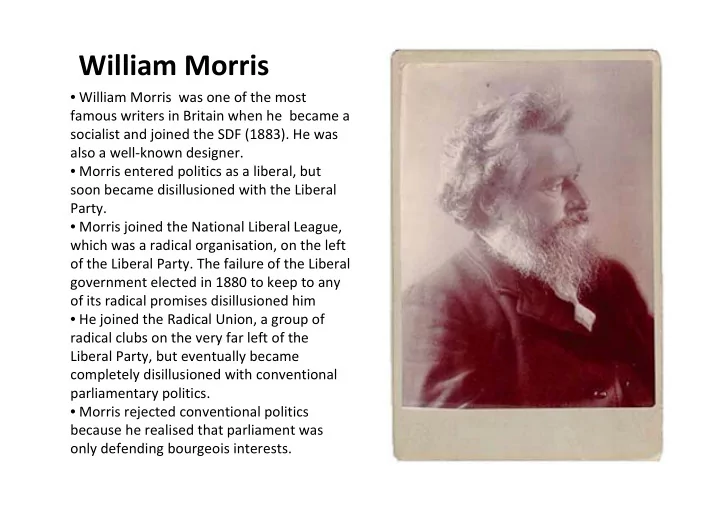

William Morris • William Morris was one of the most famous writers in Britain when he became a socialist and joined the SDF (1883). He was also a well-known designer. • Morris entered politics as a liberal, but soon became disillusioned with the Liberal Party. • Morris joined the National Liberal League, which was a radical organisation, on the left of the Liberal Party. The failure of the Liberal government elected in 1880 to keep to any of its radical promises disillusioned him • He joined the Radical Union, a group of radical clubs on the very far left of the Liberal Party, but eventually became completely disillusioned with conventional parliamentary politics. • Morris rejected conventional politics because he realised that parliament was only defending bourgeois interests.
The SDF and the split • 1883: William Morris is converted to socialism, studies Marx’s Capital (in French, because no English translation exists), and joins the Democratic Federation, soon to become the Social Democratic Federation • Morris falls out with SDF leader Henry Hyndman over Hyndman’s high-handed manner and his advocacy of using parliament and struggle for palliatives as stepping stones to revolution. Although Morris never dogmatically opposed parliamentary activity, or battle for reforms, he thought what they were taking people away from the central issues of organising and educating the workers to take over the means of production. • 1884: Letters that have come to light recently show that Morris never intended to leave the SDF, but he seems to have been persuaded in the last few days before the split. After a falling out between Morris and Hyndman, he and his supporters won the vote on the Executive, but then Morris led them out of the SDF, • 1885: The Socialist League was formed by Morris and others including Eleanor Marx (with the support of Frederick Engels).
• Feb 1885: The Commonweal was established as the Socialist League Socialist League’s journal, edited by Morris crippled by • The Socialist League was a heterogeneous organisation, including Fabians, Christian Socialists, anarchists and Marxists. sectarianism • 1886: Morris became disappointed with the progress of the Socialist League, which had only recruited 230 members, though Morris was a keen speaker who managed to set up many branches almost single-handedly. • 1887: At the 3rd Annual conference, the anarchist faction of the group managed to take control. Morris was criticised by Engels for going along with the anarchists. • 1888-1890: SL declines. Eventually Morris, never an anarchist, was stripped of the editorship of the Commonweal and left the group in 1890. • Morris himself said, the job was first to educate the workers on the need for socialism, and then to organise them to achieve it; and, as far as the Socialist League was concerned, they had not organised the workers to do anything.
Morris’ Politics and New Unionism • Morris is often characterised as a utopian socialist, at odds with the new union movement. Morris was concerned that working class activists could be distracted by petty patchwork reform. However he was not hostile to union organisation or dogmatically anti-electoralist. • 1889: During the London dock strikes, Morris began to change his mind over the role of unions and strike action. At the start of the strike Morris was worried that the workers were working in a “scattered and skirmishing way”. However as the strike progressed Morris was impressed by the strikers’ resolve. • In September 1889, Morris wrote “Lessons for the Hour”, an article for Commonweal, praising the dock strikes “But this is a revolt against oppression...and there is no doubt that nothing except the physical force of the executive prevents the revolt from achieving far more success than the attainment of its immediate and declared aims” • After 1892 Morris began to reconcile his differences with the SDF. He did not rejoin the SDF but ended his breach with Hyndman and wrote several articles for the SDF journal, Justice. On 16 June,1894 Morris wrote “How I became a Socialist” for Justice, which he sums up his development as a socialist. He died in 1896 of “simply being William Morris, and having done more work than most ten men”.
Recommend
More recommend